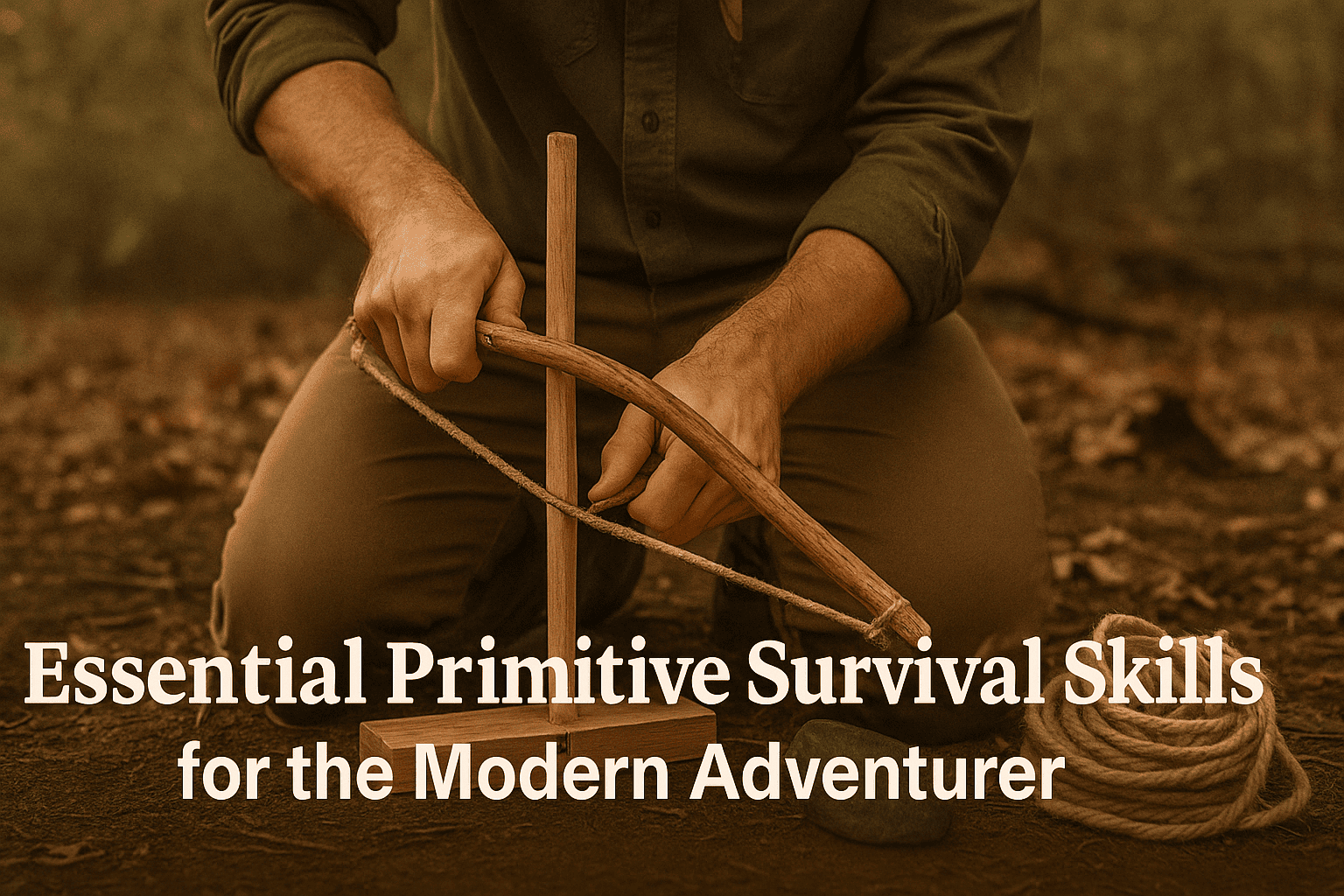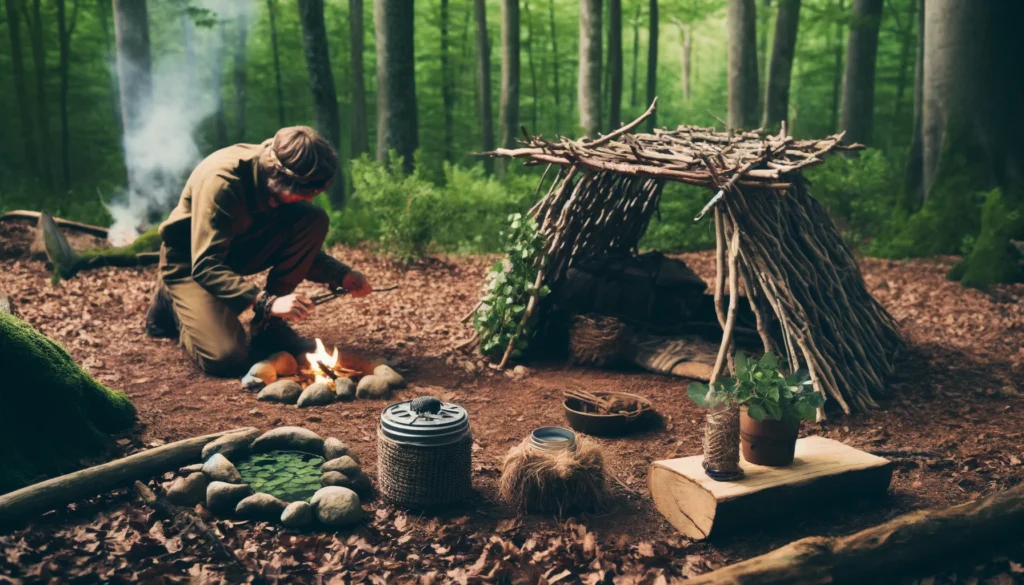Essential Primitive Survival Skills for the Modern Adventurer


Table of Contents
- Introduction
- 1. Building a Shelter
- 2. Creating Fire
- 3. Finding and Purifying Water
- 4. Foraging for Food
- 5. Navigation Skills
- 6. Tool Crafting
- 7. Signaling for Help
- 8. Knot Tying
- 9. First Aid Skills
- 10. Building Insulating Bedding
- 11. Mental Resilience
- 12. Leaving No Trace
- Conclusion
- Frequently Asked Questions (FAQs)
Introduction
In a world dominated by technology, the art of primitive survival skills remains a vital discipline for outdoor enthusiasts and anyone interested in reconnecting with nature. These skills, which have been used by humans for millennia, not only prepare you for unexpected situations but also deepen your understanding of the natural world. Here’s a guide to some fundamental primitive survival skills that everyone should know.
1. Building a Shelter
1.1 Importance of Shelter
- Protection from Elements: A well-built shelter can protect you from wind, rain, and extreme temperatures, which is crucial for survival.
1.2 Types of Shelters
- Lean-to Shelter: Easy to construct with branches and foliage; it provides good protection against wind and rain.
- Debris Hut: Made from leaves, branches, and other natural debris; excellent insulation and waterproofing.
2. Creating Fire
2.1 Methods for Starting Fire
- Friction-based Fire Making: Using tools like the bow drill or hand drill to generate heat through friction, igniting tinder.
- Flint and Steel: Striking flint against steel to create sparks that ignite a tinder bundle.
2.2 Fire Maintenance
- Sustaining Fire: Once ignited, gradually add larger pieces of wood to maintain and control the fire. The fire provides warmth, a means to cook food, purify water, and signal for help.
3. Finding and Purifying Water
3.1 Locating Water Sources
- Natural Collection: Look for streams, rivers, or collect dew and rainwater. In arid areas, understanding the landscape can lead to hidden sources of water.
3.2 Water Purification
- Boiling: The most reliable method to purify water. Use fire to boil water for at least one minute to kill harmful pathogens.
- Natural Filters: Use sand, charcoal, and stones to create a makeshift filter to remove debris before boiling.
4. Foraging for Food
4.1 Edible Plants
- Safe Foraging: Learn to identify edible plants and berries. Avoid plants with milky sap, thorns, or fine hairs, which are often indicators of toxicity.
4.2 Hunting and Trapping
- Primitive Techniques: Construct simple snares or traps to catch small animals. Understanding animal tracks and behavior is crucial for successful trapping.
5.1 Using Natural Indicators
- Sun and Stars: The sun rises in the east and sets in the west, which can guide your direction during the day. Stars, especially the North Star, are useful at night.
5.2 Making Improvised Compasses
- Shadow Stick Method: Place a stick in the ground and mark the end of its shadow with a stone; this will give you a rough east-west line.
6. Tool Crafting
6.1 Making Tools from Nature
- Stone Tools: Flintknapping to create cutting tools or weapons.
- Wood Tools: Carving wood to make spears or digging tools.
7. Signaling for Help
7.1 Visual Signals
- Smoke by Day: Create a signal fire using green vegetation to produce smoke.
- Light at Night: Use reflections or make a fire to signal your location.
7.2 Audio Signals
- Sound: Use whistles, bang rocks together, or use branches against trees to create noise that can attract rescuers.
8. Knot Tying
8.1 Essential Knots
- Versatile Knots for Survival: Master basic knots like the bowline (for creating a loop that won’t tighten), the square knot (for joining two ropes), and the taut-line hitch (adjustable knot for securing shelters).
8.2 Practical Applications
- Use in Shelter Building and More: Use your knot skills to construct sturdy shelters, set up traps, or secure gear. Effective knot tying increases the functionality and reliability of your handmade tools and structures.
9. First Aid Skills
9.1 Natural Remedies
- Using Local Resources: Learn about medicinal plants that can help treat minor wounds, soothe irritations, or relieve pain. Common examples include willow bark for pain relief (natural aspirin) and aloe vera for burns.
9.2 Emergency Treatments
- Handling Injuries: Know basic first aid techniques such as how to treat sprains, fractures, cuts, and burns. Understanding how to stabilize injuries can prevent complications until professional medical help can be reached.
10. Building Insulating Bedding
10.1 Creating a Warm Bed
- Using Natural Materials: Collect leaves, grass, or pine needles to make a thick, insulated bedding that keeps you off the cold ground. Layering these materials properly can significantly increase warmth and comfort during the night.
10.2 Importance of Bedding
- Prevention of Hypothermia: Staying warm is crucial in a survival situation, especially at night when temperatures drop. Proper bedding is essential to conserve body heat.
11. Mental Resilience
11.1 Staying Positive
- Psychological Survival: The ability to stay calm and maintain a positive outlook is crucial in survival situations. Mental stress can impact physical stamina and decision-making.
11.2 Stress Management Techniques
- Meditation and Mindfulness: Simple techniques such as deep breathing, meditation, or setting small, manageable goals can help maintain mental clarity and reduce panic.
12. Leaving No Trace
12.1 Environmental Consideration
- Minimizing Impact: Practice the principles of Leave No Trace to ensure your survival activities do not harm the natural environment. This includes properly disposing of waste, minimizing fire impact, and disturbing the ground as little as possible.
12.2 Sustainability Practices
- Resource Conservation: Use resources sparingly. Overusing resources like firewood or edible plants can lead to ecological imbalance. Always consider the sustainability of your actions.
Conclusion
Mastering these primitive survival skills can significantly increase your self-reliance and safety in the wilderness. They encourage a deeper connection with nature, enhancing your outdoor experiences and preparing you for unforeseen challenges. Remember, practice is key to proficiency, so regularly hone these skills during your outdoor adventures.
Frequently Asked Questions (FAQs)
How do I practice these skills safely?
- Start in a controlled environment, possibly with an experienced guide. Gradually increase the complexity of your survival scenarios as you gain confidence.
What are the first skills I should learn?
- Focus on fire making and shelter building as these will have the most immediate impacts on your survival in most situations.
Are these skills legal to practice in all wilderness areas?
- Check local regulations. Some activities, like foraging and setting traps, may be restricted in certain areas to protect the ecosystem or due to safety concerns.
How do I practice these skills safely?
- Start in a controlled environment, possibly with an experienced guide. Gradually increase the complexity of your survival scenarios as you gain confidence.
What are the first skills I should learn?
- Focus on fire making and shelter building as these will have the most immediate impacts on your survival in most situations.
Are these skills legal to practice in all wilderness areas?
- Check local regulations. Some activities, like foraging and setting traps, may be restricted in certain areas to protect the ecosystem or due to safety concerns.







